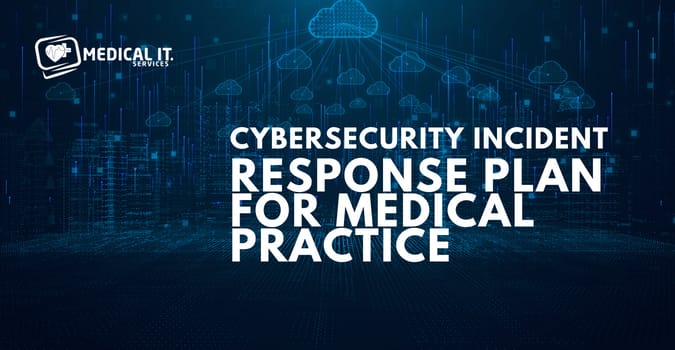Healthcare organisations rely on robust IT systems to manage patient records, facilitate telemedicine and support…

Cybersecurity Incident Response Plan for Medical Practice
In an age where healthcare organisations increasingly rely on digital technologies and electronic health records (EHRs), the risk of cyber threats is a pressing concern. Protecting sensitive patient data and ensuring the smooth operation of medical practices in the face of cybersecurity incidents is paramount. A well-defined Cybersecurity Incident Response Plan (CIRP) is a critical component in mitigating potential cyber threats effectively. In this article, we’ll outline the essential steps and considerations for creating a cybersecurity incident response plan tailored to the specific needs of a medical practice.
1. Understanding the Cybersecurity Risks in Healthcare:
Healthcare organizations, including medical practices, handle highly sensitive patient data, making them attractive targets for cyber-attacks. Understanding the specific risks, such as data breaches, ransomware, and unauthorized access to patient records, is crucial to building an effective incident response plan.
2. Compliance with Regulations:
Medical practices must comply with various regulations and standards, such as the Health Insurance Portability and Accountability Act (HIPAA) in Australia. Ensure that your incident response plan aligns with these regulations to avoid legal and financial consequences.
Related Article: The Future of Cybersecurity in the Healthcare Industry
3. Forming a Dedicated Response Team:
Establish a dedicated incident response team within the medical practice, comprising members from IT, security, legal, compliance, and management. Clearly define roles and responsibilities to ensure a swift and coordinated response to any cybersecurity incident.
4. Identifying Critical Assets and Data:
Identify and prioritize critical assets, including EHR systems, patient databases, medical devices, and communication systems. Classify patient data and other sensitive information to understand the potential impact of a breach on the practice and its patients.
5. Developing the Incident Response Plan:
Design a comprehensive incident response plan that encompasses pre-incident, incident, and post-incident activities. Define clear steps for incident detection, assessment, containment, eradication, recovery, and lessons learned.
6. Incident Classification and Severity Levels:
Define incident categories and severity levels specific to the healthcare environment. Categories could include unauthorized access, data breaches, malware attacks, and medical device compromises. Assign severity levels based on the potential harm to patients and the organization.
7. Incident Identification and Reporting Procedures:
Establish procedures for identifying and reporting cybersecurity incidents within the medical practice. Encourage all staff to promptly report any unusual activities, and provide clear guidelines for reporting channels and protocols.
8. Incident Investigation and Analysis:
Detail the steps for investigating and analyzing cybersecurity incidents, including forensics, malware analysis, and root cause analysis. Ensure compliance with legal and regulatory requirements during the investigation process.
9. Containment and Mitigation Strategies:
Define strategies to contain the incident and mitigate potential damage swiftly. Include protocols for isolating affected systems, disconnecting compromised devices, and implementing temporary workarounds to maintain critical services.
10. Recovery and Restoration Plan:
Outline a systematic approach to recover affected systems and restore data from secure data backups. Ensure that the recovery process is thorough, validated, and conducted in a controlled and secure manner to prevent further incidents.
11. Communication and Notification Protocols:
Establish clear communication and notification procedures for both internal and external stakeholders. Address how to inform patients, regulatory bodies, law enforcement, and the public in case of a data breach or other significant incidents.
12. Training and Drills:
Regularly train employees on cybersecurity best practices, incident response procedures, and the specific aspects of the incident response plan. Conduct periodic drills and tabletop exercises to evaluate the team’s readiness and identify areas for improvement.
Conclusion:
Building a cybersecurity incident response plan tailored to the unique requirements of a medical practice is fundamental in safeguarding patient data and ensuring uninterrupted healthcare services. By partnering with MedicalIT.Services, and healthcare practices can effectively mitigate the impact of cyber threats and maintain the trust and well-being of their patients. We specialize in empowering medical practices by providing advanced cybersecurity solutions and incident response strategies. Contact us to fortify your defenses, enhance incident preparedness, and ensure the confidentiality and integrity of patient information.
Also Read:



